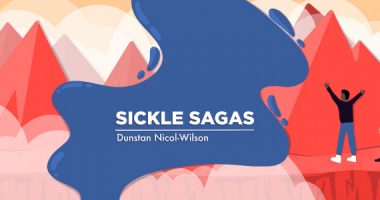Survey Reveals Shortfalls in SCD Care, Economic Burden

Lowering the risk of long-term complications, including organ damage and hemolytic anemia — driven by the destruction of red blood cells — are common goals for sickle cell disease (SCD) patients, caregivers, and healthcare professionals, according to data from Global Blood Therapeutics’ international SHAPE survey.
Survey results also demonstrated SCD has a significant detrimental impact on patients’ everyday life, including their ability to attend and succeed at school or work, which may affect their earning potential. Caregivers also face profound physical, psychosocial, and economic burdens.
“The SHAPE survey is important because it illustrates how vital it is that we understand our patients’ needs, and it suggests what we within the medical community can do to help change perspectives, increase education and awareness, and improve care,” Baba Inusa, MD, said in a press release. Inusa is a professor and consultant of pediatric hematology at Guy’s and St Thomas’ NHS Foundation Trust, in London.
The part of the SHAPE survey — an acronym for Sickle Cell Health Awareness, Perspectives and Experiences — addressing healthcare professionals revealed the need for more educational tools to mitigate the disease’s long-term effects and increase overall awareness and understanding of SCD.
“These results are a wake-up call, and I believe that the actions that follow can enable us to help drive a better dialogue and improved conversations around the management and care of this long-neglected and devastating disease,” added Inusa, who also is one of the members of SHAPE’s Steering Committee of SCD expert clinicians and patient advocates.
The findings from patients and caregivers were presented in an oral presentation at the 4th Global Congress on Sickle Cell Disease, held in Paris, June 16–18. The presentation was titled “Cell Health Awareness, Perspectives and Experiences (SHAPE) Survey: Findings on the Burden of Sickle Cell Disease and Unmet Needs as Reported by Patients and Caregivers.”
The SHAPE survey was completed by 919 SCD patients (mean age 32.3 years) and 207 caregivers across 10 countries. The majority of patients and caregivers were women.
Almost all patients (93%) reported that one of their goals was to reduce the risk of organ damage, and other long-term health issues linked to SCD.
In the past year, fatigue and tiredness were experienced by 84% of the patients, which affected their ability to attend school and work and, consequently, affected their earning potential. This had caused them to lose, on average, 7.5 days of school/work in the past month.
Mental health also was affected, with more than half of the patients (62%) reporting feeling depressed, having a low mood or feeling down, while 57% felt worry or nervousness in the past year.
“The challenges for patients seem endless and this survey highlights that, in spite of this, patients do not feel heard. They continue to face acute physical but also emotional damage, stigma and discrimination,” said Dianaba Ba, who lives with SCD. Ba also is director of operations at SOS GLOBI: The Federation of Sickle Cell and Thalassemic Patients, a SCD patient advocacy organization in France.
Receiving care from a SCD specialist was associated with more positive experiences than when patients were seen by general healthcare professionals and emergency department physicians. The main reason respondents cited was the lack of knowledge about SCD.
“SCD is the reality of so many people around the world, and yet patients often experience poor care, especially by non-specialist healthcare providers who may lack the training to provide good comprehensive care. In recent years, we’ve started to see some positive change, but it is still not enough,” Ba added.
SCD also had a marked negative impact on caregivers’ lives: 56% reported an impact on their ability to attend and succeed at school or work; 53% on their overall well-being; and 52% on mental health.
“Our aim for this survey is to add to the body of knowledge around better understanding and characterizing the misunderstood, under-reported experiences and unmet needs of people living with SCD, as well as those caring for and treating people with the condition,” said Kim Smith-Whitley, MD, executive vice president and head of research and development at GBT.
The results from the healthcare professionals part of the survey were presented in a poster at the European Hematology Association (EHA) 2022 Hybrid Congress that ran in-person in Vienna, Austria, and virtually, June 15–17. The poster was titled “Sickle Cell Health Awareness, Perspectives and Experiences (SHAPE) Survey: Findings on the Burden of Sickle Cell Disease on Patients and Their Unmet Needs As Reported by Healthcare Professionals.”
Although fatigue and tiredness created a dramatic burden to SCD patients’ lives, only 53% of healthcare professionals believed they had the tools to lessen these symptoms. The majority (84%) believed that treatment of hemolytic anemia could lessen SCD severity, including reducing organ damage.
While more than half of healthcare professionals (78%) were confident in their knowledge of the long-term effects of SCD, 83% of them said more support was needed to educate patients on this particular aspect of the disease. In fact, significantly more than half of healthcare professionals (66%) reported that patients often fail to understand this aspect of SCD.
In 37% of the cases, healthcare professionals were reluctant to raise potential future challenges with patients or their families.
A third of them (31%) had trouble in completely understanding patients’ concerns. Differences in ethnic backgrounds were reported as a cause for this difficulty in 43% of the cases.
The majority of healthcare professionals (82%) recognized the financial burden to patients that stems from SCD, and how this may affect their access to care.
“These results provide the opportunity to leverage multinational perspectives and experiences to help drive more attention about sickle cell disease and improve dialogue around the treatment, management and care of these patients,” said Smith-Whitley.
“GBT is committed to being part of shaping change within the global SCD community, and we are grateful to all those who participated in and contributed to this important research,” she added.








